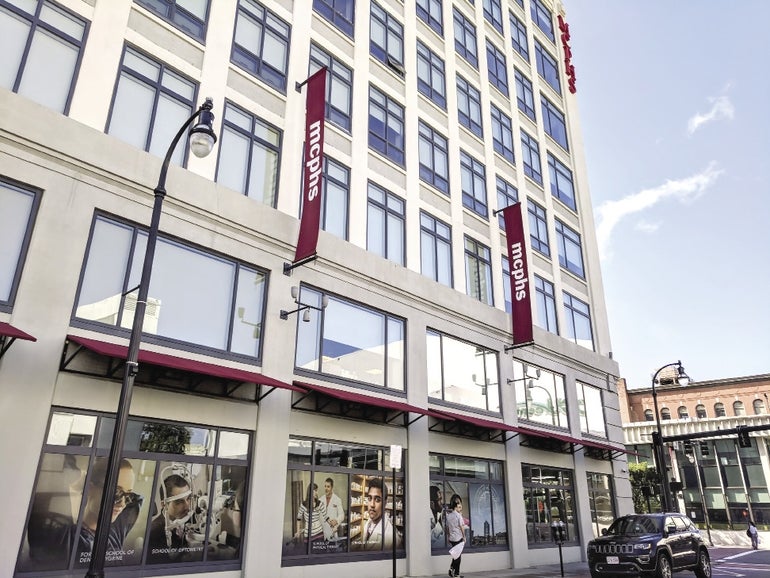MCPHS University isn’t by a long shot Worcester’s oldest, largest or most selective college. But no college has grown so exponentially in the nearly two decades MCPHS has been in Worcester, or contributed as much to a presence of higher education in the city’s downtown.
Today, Quinsigamond Community College has an academic center downtown, and Becker College has dormitories. Neither was downtown when MCPHS opened in Worcester in 2000.
“I don’t know if any of them would have taken the chance without MCPHS’s success in paving the way,” said Jeanine Went, the executive director of the Higher Education Consortium of Central Massachusetts, whose downtown office on Norwich Street sits amid MCPHS classrooms and residences.
Unlike, say, Worcester State University or the College of the Holy Cross, there can be little to indicate to a student or visitor they’re at MCPHS. The campus is tightly woven into downtown because MCPHS has grown without adding a single new building of its own.
Looking to stretch its legs
When it came to Worcester, MCPHS – then the Massachusetts College of Pharmacy and Health Sciences – had outgrown its main Boston campus, which is located among Harvard Medical School, Boston Children’s Hospital, Brigham and Women’s Hospital and Beth Israel Deaconess Medical Center. That has put it in great company, but also without any room for new classrooms.
“We can’t grow in Boston,” said Charles Monahan, the MCPHS president since 1997. “There isn’t a square foot to rent or buy.”
There was, however, room in Worcester, and Monahan – a Worcester native – has turned to his home city for much of the school’s enrollment growth and new programs.
“We were looking for growth because there was no place to grow,” Monahan said. “We’re committed to Worcester. Worcester is our growth area.”
MCPHS first opened in a single building at 19 Foster St., with an accreditation for just 150 students per academic class. Growth since then has been incremental but fast: by 2007, enrollment was nearly 600, and by 2012, it surpassed 1,100.
It’s now approaching 2,000 students, Monahan said, and offers 12 degrees in Worcester.
18 properties & counting
The initial Foster Street building was soon after joined by another at 25 Foster St., a $45-million Living and Learning Center with classrooms, a library and residences for around 145 students. A third building on Foster Street opened in 2009; and in 2012, the school made an ambitious move solidifying its role helping to transform a swath of the city, turning the former Crowne Plaza hotel into residences, a student center and home for its optometry program. The site has since been expanded with a $10-million, 54,000-square-foot wing.
Less visible has been the school’s purchase of three residential properties each on Salisbury Street and Lancaster Street to offer housing for students. In 2013, the school bought the former Morgan Construction Co. building at 15 Belmont St., which furthered the school’s geographic expansion.
MCPHS is just using the Belmont Street site for parking for now. The school is studying what to do long term with the nearly three-acre site and the 87,000-square-foot building, and MCPHS isn’t yet sure, Monahan said.
“Eventually, we’ll be putting something in there,” he said.
The school – which has only graduate students in Worcester — now owns 18 properties in the city. Its white lab coat-clad students can be seen walking anywhere from Worcester Common to Lincoln Square.
“I would attribute the success of MCPHS to Charlie Monahan,” Went said. “He’s Worcester’s favorite son. He really jumpstarted the growth of new business downtown because he took the chance at buying up properties downtown for higher education.”
Acupuncture & beyond
MCPHS isn’t especially selective, admitting 84 percent of applicants, according to U.S. News & World Report, and last year, the Massachusetts Board of Registration in Nursing warned MCPHS on concerns it had about oversight of its Boston nursing program.
But the median starting salary of MCPHS graduates is $59,000, according to the U.S News & World Report, and the school says it has an 82-percent return rate for first-year students. Money magazine named it the most transformational college in the country for the 2018-19 school year based in large part on early-career earnings and price for students after aid.
Lately, MCPHS’s growth has taken place not with new buildings but new programs. Pharmacy now accounts for only 30 percent of MCPHS’s enrollment, as the school has expanded into dental hygiene, medical imaging, therapeutics and, most recently, acupuncture and optometry.
The optometry program is one of only 23 in the country to be members of the Association of Schools and Colleges of Optometry, and one of just two in New England, along with the New England College of Optometry in Boston.
Worcester has MCPHS’s acupuncture program, which was moved from Newton, where the then-New England School of Acupuncture was based when MCPHS bought it in 2015. Monahan said he believes the program – which says it was the first in the United States, founded in 1974 – will rise in demand as more turn to non-opioid pain treatments.
More programs will be on the way in Worcester, too, Monahan emphasized.
“We’re on a roll in Worcester,” he said, “and we’re going to keep rolling.”

